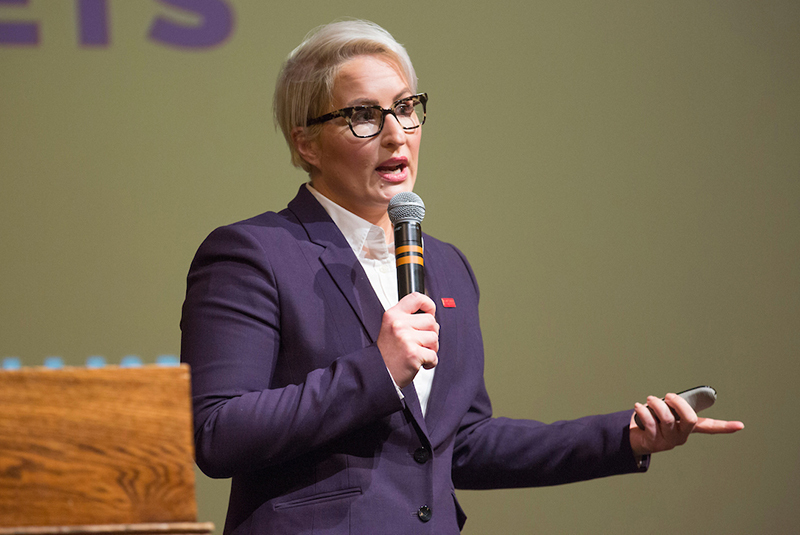Idea-sharing alliance drives innovative Iowa State student success efforts
Author: Dave Roepke
This is an archived story. The content, links and information may have changed since the publication date.
Author: Dave Roepke

Bridget Burns, executive director of the University Innovation Alliance, spoke Feb. 5 at Iowa State's campus symposium on closing the student achievement gap. Iowa State is a founding member of the 11-university alliance. Photo by Christopher Gannon.
A first-of-its-kind collaboration with 10 other large public research universities has been the driving force behind numerous recently established Iowa State initiatives designed to help more students thrive.
The efforts were guided or inspired by the University Innovation Alliance (UIA), which Iowa State co-founded in fall 2014. UIA members share strategies for assisting students of color, first-generation students and low-income students, with hopes of replicating what has worked and avoiding what has not. While faculty from different universities frequently partner on academic research, institutions traditionally are less forthcoming about their approaches to improving student outcomes.
"We're trying to encourage people to think you don't have to tinker in a silo," UIA executive director Bridget Burns said Monday at the Memorial Union.
Burns was the keynote speaker at an Iowa State data symposium on closing the achievement gap, which included an in-depth presentation on ISU graduation and retention rates for numerous demographics and breakout sessions on related topics with students, staff, faculty and administrators.
"We learned in these conversations that we cannot treat all of our students the same, that every student has a unique set of talents and skills, and that we need to be intentional about how we work with each of those students so they have the tools they need to be successful," President Wendy Wintersteen said in her closing remarks.
The alliance aims to meet the rising need for college graduates by boosting the number of degrees granted and the diversity of graduates at 11 universities, which have a combined enrollment of about 400,000 students. It's working, according to data shared by Burns.
UIA's initial goal was to produce an additional 68,000 degrees by 2025, half to be earned by low-income students -- a population whose degree attainment has been flat for decades, even as a college education has become standard for students from high-income families. UIA schools are on track to beat the initial goal with an increase of about 94,000 degrees in its first decade. From 2014 to 2017, the number of degrees UIA institutions granted to low-income students eligible for Pell Grants increased 25 percent.
"We can make change at scale if we work together and be strategic," Burns told a crowd of about 150 people.
The alliance has promoted a set of initiatives adopted by all member institutions, such as the full-time fellows at each university devoted to creating, managing and monitoring new programs. The other efforts employed by UIA schools include:
Iowa State also has tackled some projects inspired by the alliance, UIA fellow Gralon Johnson said. A meeting of stakeholders in February 2017 produced a number of ideas, including the Feb. 5 data symposium. An effort to create a central inventory and common nomenclature for Iowa State's student success programs also is underway, Johnson said.
Following the lead of fellow UIA institution Michigan State, ISU's current study of the student onboarding process was UIA-inspired, Johnson said. Recommendations on how to streamline communication with incoming students are expected this spring.
A recent decision to end the summer trial enrollment program, which allowed prospective students who didn't meet admissions requirements to take summer classes, also was in the spirit of the UIA's aim to abandon what isn't working. Associate vice president for enrollment management and student success Laura Doering said during a breakout session that the six-year graduation rate for summer trial participants was just 39 percent.
Iowa State's longstanding and successful use of learning communities -- three out of four freshmen join one of the 90 communities -- was a key reason it was invited to help form the alliance. But Arizona State president and alliance chair Michael Crow (an Iowa State alumnus and faculty member from 1988 to 1991) told a newly appointed President Wintersteen it wasn't the only reason. Crow told her Iowa State is in the alliance because of its commitment to accessibility and the land-grant mission. It seeks to educate more than just top-performing students.
Working to do that better is difficult, but change is coming, Burns said.
"You're in the midst of a complete transformation at Iowa State," she said. "Ten years from now, your students will be experiencing a fundamentally different institution."